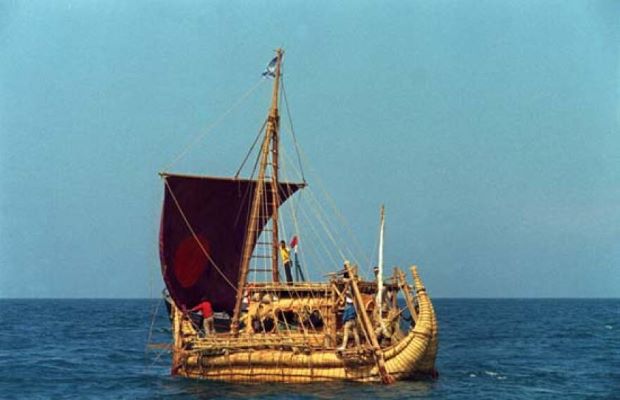May 17 in History
1970 - Norwegian ethnologist Thor Heyerdahl sails across the Atlantic Ocean on a papyrus boat
On this day in 1970, Norwegian ethnologist Thor Heyerdahl and a multinational crew set out from Morocco across the Atlantic Ocean in Ra II, a papyrus sailing craft modelled after ancient Egyptian sailing vessels. Heyerdahl was attempting to prove his theory that Mediterranean civilizations sailed to America in ancient times and exchanged cultures with the people of Central and South America. The Ra II crossed the 4,000 miles of ocean to Barbados in 57 days.
Heyerdahl, born in Larvik, Norway, in 1914, originally studied zoology and geography at the University of Oslo. In 1936, he travelled with his wife to the Marquesas Islands to study the flora and fauna of the remote Pacific archipelago. He became fascinated with the question of how Polynesia was populated. The prevailing opinion then (and today) was that ancient seafaring people of Southeast Asia populated Polynesia. However, because winds and currents in the Pacific generally run from east to west, and because South American plants such as the sweet potato have been found in Polynesia, Heyerdahl conjectured that some Polynesians might have originated in South America.
To explore this theory, he built a copy of a prehistoric South American raft out of balsa logs from Ecuador. Christened Kon-Tiki, after the Inca god, Heyerdahl and a small crew left Callao, Peru, in April 1947, traversed some 5,000 miles of ocean, and arrived in Polynesia after 101 days. Heyerdahl related the story of the epic voyage in the book Kon-Tiki (1950) and in a documentary film of the same name, which won the 1952 Oscar for Best Documentary.
Heyerdahl later became interested in the possibility of cultural contact between early peoples of Africa and Central and South America. Certain cultural similarities, such as the shared importance of pyramid building in ancient Egyptian and Mexican civilizations, perhaps suggested a link. To test the feasibility of ancient transatlantic travel, Heyerdahl built a 45-foot-long copy of an ancient Egyptian papyrus vessel in 1969, with the aid of traditional boatbuilders from Lake Chad in Central Africa. Constructed at the foot of the Pyramids and named after the sun god Ra, it was later transported to Safi in Morocco, from where it set sail for the Caribbean on May 24, 1969. Defects in design and other problems caused it to founder in July, 600 miles short of its goal. It had sailed 3,000 miles.
Undaunted, Heyerdahl constructed a second papyrus craft, the Ra II, with the aid of Aymaro Indian boatbuilders from Lake Titicaca in Bolivia. With a multinational crew of seven, the Ra II set sail from Safi on May 17, 1970. After a voyage of 57 days and 4,000 miles, the ship arrived in Barbados. The story of this voyage is recorded in the book The Ra Expeditions (1971) and in a documentary film.
In 1977, Heyerdahl led the Tigris expedition, in which he navigated a craft made of reeds down the Tigris River in Iraq to the Persian Gulf, across the Arabian Sea to Pakistan, and finally to the Red Sea. The goal of the expedition was to establish the possibility that there was contact between the great cultures of Mesopotamia, the Indus Valley, and Egypt across the sea. Heyerdahl later led research expeditions to Easter Island and an archaeological site of Tucume in northern Peru. For the most part, Heyerdahl’s ideas have not been accepted by mainstream anthropologists.
-history.com



Comments are closed, but trackbacks and pingbacks are open.